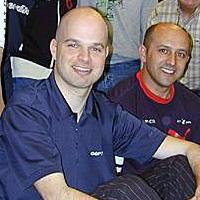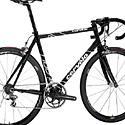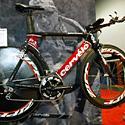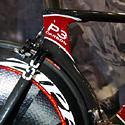
Recently on Cyclingnews.com |
Tech feature - November 25, 2004
An interview with Gerard Vroomen
Cervélo takes aim at weight limits with the Bayonne

|
Canadian bike company Cervélo continues to make major inroads into the competitive medium- to high-end of the road market. Company principal Gerard Vroomen told Cyclingnews how he sees the market developing over the next year, especially with "black aluminium" becoming a feature of almost every bike range.
Cervélo has been one of the road bike success stories of the last few years, riding the road bike boom and its cannily-timed sponsorship of the CSC team to rapidly develop from a time trial bike specialist to one of the best-regarded makers of high-end road machines.
With its new sub-kilogram R2.5 Bayonne carbon fibre frame, a composite version of the signature P3 time trial frame plus a successful ongoing collaboration with Denmark's Team CSC, Cervélo has plenty of marketing at its disposal for 2005, and Cervélo co-founder Gerard Vroomen is pretty happy with how 2004 went too.
"This year was pretty successful for Cervélo, we've been shipping like crazy," he told Cyclingnews. Once again, Cervélo's relationship with the division 1 squad, CSC, has paid major dividends. Even though the Danish team lost its high-profile North American rider when Tyler Hamilton joined Phonak, 2004 has seen a resurgent Bobby Julich at CSC and in his 'comeback' year, Julich also secured the first Olympic medal for a rider on a Cervélo.
"Everyone said the team (CSC) would be weaker this year, but they were wrong," he said. Cervélo watched the inexorable rise of Ivan Basso to become a genuine Tour de France contender, as well as TdF stage wins, Paris-Nice, Criterium International and an Olympic medal, the company has fired plenty of shots into the competition.

|
And that ammunition is important, as it could be argued that the bike industry has become a marketing battleground. What was once exotic has now become common; lightweight frames and components made from carbon fibre are everywhere.
However, Vroomen - the engineer - is quick to point out that just because a frame is made of carbon, it doesn't necessarily mean it's better than a frame made from a more 'traditional' material.
"Put it this way, if I were a consumer I'd rather have a two thousand dollar aluminium bike rather than a two thousand dollar carbon bike, because you know that aluminium bikes have got to the point that the really bad ones have been eliminated; the people making them know what they're doing. The same can't be said for carbon fibre," he said to Cyclingnews after spending a good proportion of the final day of 2004 Interbike checking what other companies had on display.
"The price point of carbon is coming down. For 90 percent of the stuff that is at this show [Interbike 2004], it's like everyone has one, but you can see they're rushing to market. There is a price limit where you can do carbon, but can't do it well. Just like with aluminium frames we now see the same trend in carbon, companies try to offer the cheapest Dura-Ace or Ultegra-equipped bike on the market. But in the long run you can't compete there, because Giant will always beat you on price thanks to their volume. So if you cannot be the cheapest, you need to be the best."
Quality control vital
The vast majority of bicycles - even some of those ridden in the Tour de France - now come out of factories in Taiwan or China. It's to do with cost, for the same reason running shoes are made in third world countries.
They may not have Chinese names, as the frame manufacture is sub-contracted to specialist OEM (original equipment manufacture) firms in Asia, but they are offered by some of the most venerable names in road racing.

|
This form of production is not something that Cervélo has ever tried to hide; rather, Vroomen has always been quite honest about the company philosophy. He believes the original design is most important, as is quality control to ensure the product is made to its specification. But where it's made? In 2002, Vroomen told Cyclingnews, production is "sort of a black box with design and engineering as the input and quality control for what comes out of it, and that by taking care of those three issues the end result will be a good bike". At the time he wondered if consumers really cared who actually made the frames as long as they are of excellent design and meet strict quality controls.
In 2004, the outsourcing has taken on a new dimension - the OEM factories have gotten up to speed on carbon fibre and so they can offer frames like they do aluminium. "A lot of these small companies are now popping up that used to make aluminium frames that are now getting into carbon, but it's not that easy," he said.
"On the other hand, most of the composite frames, so far, have come from just a couple of factories. They throw in a little difference in a couple of the tubes to make it look different, but beyond that it's the same structure. You'd think that everyone would try to differentiate themselves, but they don't. Two years ago you could say 'this is carbon, it's something new'. But now there are a lot of carbon bikes on the market, it's like the companies are using it as 'black aluminium'," he said.
"We've consciously gone away from working with a company that has a lot of different customers. We take full control of where and how are bikes are made. We did this a few years ago for our aluminium bikes. We found a company with a mentality we were comfortable with, their quality wasn't up to our standards yet but nobody's quality was. The good thing about them was that they were interested in learning. So we sent our welding experts over and taught them how we want our frames to be welded.
"They love it. It takes a lot longer to weld the Cervélo way than the way they did before, but they are really proud of the results. If the frames don't come out the way you want them, it's not really the builder's fault if they don't know exactly what is expected. It's the way we want to do it," he said.
"We now do the same thing with carbon. There is no point in teaching a company how to make a better carbon frame if the same technologies are then used on other people's frames as well. So we picked our factory very carefully, set up the restrictions to ensure our intellectual property is safe and now we are working with them to continuously improve the products. Whereas a lot of bike companies now just send sketches to Taiwan and have the manufacturer do everything else, we feel we have to take full control of production."
Carbon fibre process evolves
One of the major new releases in 2005 for Cervélo is the R2.5 Bayonne, the new 850 gram frame. Vroomen said while the bike looks the same as the R2.5 Chorus or R2.5 Team (the CSC 'workhorse'), it features a new molding process that results in improved ply control and compaction, resulting in a lighter, stronger, and higher quality frame.
"We've worked on a replacement for the bladder molding techniques of producing carbon frame parts. There are various ways to do it and everyone does it differently," he admitted.
CSC riders use the same R2.5 Carbon frame as in the Chorus and Team models that are available to consumers, the only difference between the two is the component kit.
The R2.5 Bayonne was only used by Ivan Basso in the l'Alpe D'Huez individual time trial in this year's Tour de France. "It's something the pros can't ride because it's too light," Vroomen said of the Bayonne. Basso's Bayonne bike with Zipp Z4 wheels was so light that it was under the UCI's 6.8kg minimum weight limit, so CSC mechanics added time trial bars to bring it up to weight.
But Vroomen stresses the true measure of a good design is not to have the lowest weight, but the highest stiffness-to-weight ratio. He said the company's experience with carbon fibre gives it an understanding of the strengths and weaknesses of different materials. He said carbon fibre offers the opportunity for weight reduction when used correctly, but the selection of materials, thicknesses and how they are put together is important to provide a progressive failure mode, and absorb shock and impacts.

|
And it's on the topic of durability that Cervélo sees the UCI's 6.8kg weight limit as being ineffective. He said that a bike from another manufacturer can be one or two kilograms heavier than the Bayonne, yet not be as strong.
On a lighter note, Vroomen is definitely in favour of post-race scrutineering of official race bikes, rather than prior to the stage. There have been reliable rumours of some team mechanics using sneaky tricks to temporarily increase a bike's weight - such as even putting ice inside the tubes - so that they pass the pre-race weigh-in. A post-race weight check would level the playing field in the manner intended by the UCI's weight regulation. In fact, Vroomen was "amazed" at how one rider in the L'Alpe d'Huez TT got his bike through scrutineering, as he believed it must have been under the 6.8kg mark. "Just look at Basso, he has a bike with deep aero wheels, a regular fork instead of the superlight version, regular cranks instead of the superlight version, aluminium dropbars instead of the superlight carbon ones, and he still needs to put aerobars on the bike to make it heavy enough. At the same time there are riders who use all the lightest parts and no aerobars and somehow their bike weighs the same. That can mean two things: these companies use much more carbon in the pro frames because the consumer versions aren't stiff enough; or these bikes weren't really 6.8kg."
Another major announcement at the show was the Cervélo P3 Carbon. Vroomen said that the P3 design is very clean in an aerodynamic sense, but he and fellow designer Phil White saw the potential for improvement in the headtube area, the shape of the seattube and how it meets up with the seatstays. "We've been working on it for three years," he said. "This is definitely not the industry to 'get rich quick'."
Vroomen added that to achieve the improvements the designers had to switch to carbon, as it allowed them to make certain shapes not possible in any other way. But even in carbon, some of the shapes - in particular the seat-tube - are very difficult to achieve. "It required a mould with 12 slides; the mould-maker said it was the toughest mould he'd ever done because of those 12 slides."
So while the company has continued to work on the processes to improve composite frames, it has stopped production of the elegant steel bikes that it proudly showed as part of its range. "No, we've stopped making them because we're so busy and the steel frames take a disproportionate amount of our time," he said, but it's likely they could return in the future.
Could this be because of the falling price point for high-quality carbon fibre bikes? Quite possibly, because Vroomen points out that the R2.5 Chorus, equipped with Campagnolo Chorus, is available for US$3,100. At first glance that looks like a bargain compared to a Bayonne frame at US$3,999 but Vroomen explains that "an apples to apples comparison would be with the R2.5 frameset, which is US$2,199. The Chorus bike, while having the same frame, has a different fork, so that comparison is a bit off."
Nevertheless, $3,999 is a fairly startling amount of money for a bicycle frame. "It is simply the law of diminishing returns," said Vroomen. "The things we have to do to the Bayonne to get the last grams out of this frame while maintaining the high durability and stiffness standards are very expensive."

